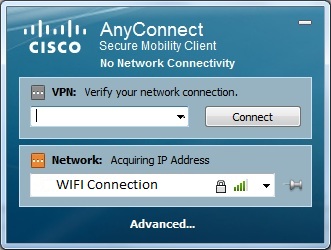Overview
- Cisco Anyconnect Secure Mobility Client Not Connecting To Wifi On Pc
- Cisco Anyconnect Secure Mobility Client Logs
- Cisco Anyconnect Secure Mobility Client Not Connecting To Wifi Windows 10
If you don't see Cisco AnyConnect Secure Mobility Client in the list of programs, navigate to Cisco Cisco AnyConnect Secure Mobility Client. When prompted for a VPN, enter su-vpn.stanford.edu and then click Connect. Enter the following information and then click OK.
Stanford's VPN allows you to connect to Stanford's network as if you were on campus, making access to restricted services possible. To connect to the VPN from your Windows computer you need to install the Cisco AnyConnect VPN client.
- Click the Ciscofolder; click the Cisco AnyConnect Secure Mobility Client folder, then rightclick the Cisco AnyConnect Secure Mobility Client icon. This will bring up a list of options. Hover over Send to, then click Desktop (create shortcut).
- Apr 15, 2021 Cisco AnyConnect Secure Mobility Client Administrator Guide, Release 4.9. Troubleshoot AnyConnect. PDF - Complete Book (6.85 MB) PDF - This Chapter (1.26 MB) View with Adobe Reader on a variety of devices.
Two types of VPN are available:
- Default Stanford (split-tunnel). When using Stanford's VPN from home, we generally recommend using the Default Stanford split-tunnel VPN. This routes and encrypts all traffic going to Stanford sites and systems through the Stanford network as if you were on campus. All non-Stanford traffic proceeds to its destination directly.
- Full Traffic (non-split-tunnel). This encrypts all internet traffic from your computer but may inadvertently block you from using resources on your local network, such as a networked printer at home. If you are traveling or using wi-fi in an untrusted location like a coffee shop or hotel, you may wish to encrypt all of your internet traffic through the Full Traffic non-split-tunnel VPN to provide an additional layer of security.
You can select the type of VPN you want to use each time you connect to the Stanford Public VPN.
Install the VPN client

- Download the Cisco AnyConnect VPN for Windows installer.
- Double-click the InstallAnyConnect.exe file.
- When a message saying the Cisco AnyConnect client has been installed, click OK.

Connect to the Stanford VPN
- Launch the Cisco AnyConnect Secure Mobility Client client.
If you don't see Cisco AnyConnect Secure Mobility Client in the list of programs, navigate to Cisco > Cisco AnyConnect Secure Mobility Client. - When prompted for a VPN, enter su-vpn.stanford.edu and then click Connect.
- Enter the following information and then click OK:
- Group: select Default Stanford split- tunnel (non-Stanford traffic flows normally on an unencrypted internet connection) or Full Traffic non-split-tunnel (all internet traffic flows through the VPN connection)
- Username: your SUNet ID
- Password: your SUNet ID password
- Next, the prompt for two-step authentication displays. Enter a passcode or enter the number that corresponds to another option(in this example, enter 1 to authenticate using Duo Push to an iPad). Then click Continue.
- You may have to scroll down the list to see all of your options.
- If your only registered authentication method is printed list, hardware token, or Google Authenticator, the menu does not display. Enter a passcode in the Answer field and click Continue.
- Click Accept to connect to the Stanford Public VPN service.
- Once the VPN connection is established, a message displays in the lower-right corner of your screen, informing you that you are now connected to the VPN.
Disconnect from the Stanford VPN
- In the notification area, click the Cisco AnyConnect icon if it is displayed. Otherwise, go to your list of programs and click Cisco AnyConnect Secure Mobility Client.
- At the prompt, click Disconnect.
Hello! We are currently deploying Zscaler App to customer and having compatibility issue with Cisco AnyConnect Secure Mobility Client. The agent is only for Network access control.
We found that the issue happen when user switch from wired network to wireless network. Both network are also connected to the same corporate network internally. When user switch network, the Cisco AnyConnect Secure Mobility Client will act as NAC solution and check for 3 things before allow the user connect to internal corporate network:
- Check if the PC is domain-joined
- Check the Antivirus is installed
- Check the Virus signature is up-to-date
After all checking are compliant, user will be allowed to access the internal corporate network.
Cisco Anyconnect Secure Mobility Client Not Connecting To Wifi On Pc
After installed Zscaler App, we found on Zscaler App that when switch between network, the ZApp will show message that indicate not able to reach internet. This is normal since Cisco agent need to complete the checking before allow the network. However after the Cisco agent completed the checking and show compliant, the ZApp still showing the same error message. We observed the symptom on the affected PC as below:
Cisco Anyconnect Secure Mobility Client Logs
- Not able to access any internal website
- Not able to access internet
- not able to resolve DNS with internal DNS server
The issue remain the same when we try to restart the checking on Cisco agent.
The issue is Intermittent and it does NOT happen every time when switch between network.
It could only be resumed when user restart the PC.
Cisco Anyconnect Secure Mobility Client Not Connecting To Wifi Windows 10
May I know if there is any previous experience sharing that install Zscaler App to Cisco ISE agent environment, or any other NAC solution?
